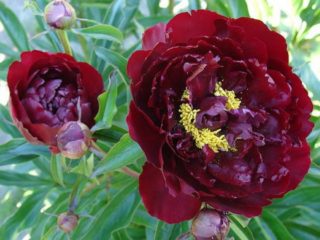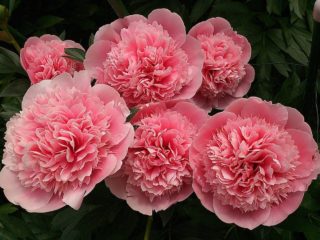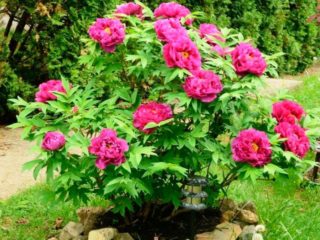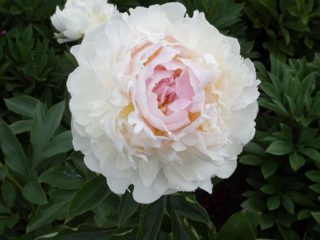Content
Peony Marie Lemoine is a perennial plant with double light cream flowers of a lush spherical shape. A variety of hybrid origin, bred in France in 1869.
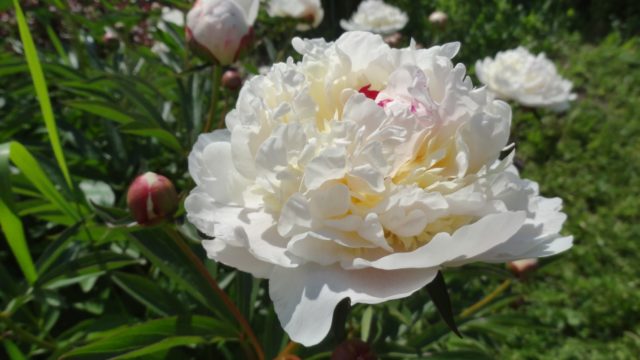
Marie Lemoine peonies bloom up to 20 cm in diameter
Description of peony Marie Lemoine
Herbaceous peonies of the Marie Lemoine variety reach 80 cm in height, forming an upright, rapidly growing bush. The stems are strong and elastic. Marie Lemoine's leaves are deep green, trifoliate, dissected and pointed. The rhizome is large, developed, with spindle-shaped thickenings.
Peony Marie Lemoine is resistant to drought and cold. It belongs to zone 3 of frost resistance - it can withstand temperatures down to -40 degrees and is able to grow in the Moscow region, the Far East, and the Urals. The Marie Lemoine variety prefers illuminated areas, but slight shading is also acceptable.
Features of flowering
Milky-flowered Marie Lemoine peonies have lush, double, crown-shaped inflorescences. The buds are single, bloom up to 20 cm in diameter, creamy pink, occasionally with a lemon tint. In the center is a funnel of white petals with crimson stripes and shortened yellow petalodes. Blooms abundantly, later (at the end of June),
lasting from 8 to 20 days, the aroma is sweetish. There are 3–8 buds on the shoots.
Application in design
The openwork bush Marie Lemoine is decorative throughout the season. During flowering, it looks impressive against the background of the lawn. Forms a harmonious combination with roses, clematis, geraniums, junipers and dwarf pines.
Marie Lemoine is popular in mixborders near gazebos and paths. Can be combined with brighter varieties (red, lilac and pink flowers) and other decorative foliage plants. Peonies are indispensable when composing bouquets and floral arrangements.
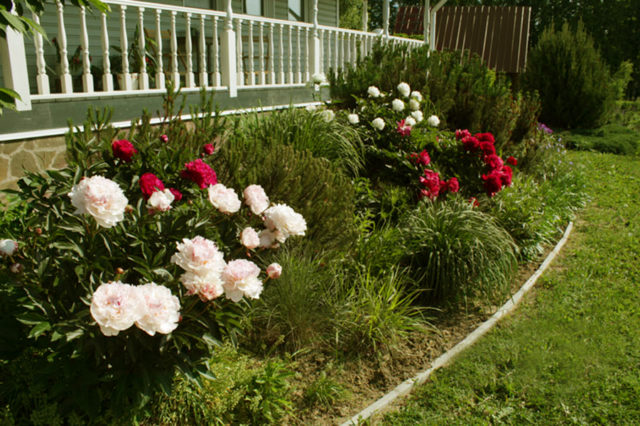
Landscape composition with peonies
Reproduction methods
Reproduction of Marie Lemoine is possible by seeds and vegetatively. An effective way is by dividing the bush. To do this, choose an adult peony (4-5 years old) with a developed root system. Separate using pruners or a sharp knife. On the daughter and mother plants it is necessary to leave roots of at least 10 cm and 2-3 buds. Division is carried out from the second half of August until the end of September. Other less popular methods: propagation by root and stem cuttings, vertical layering.
Landing rules
The Marie Lemoine variety prefers loamy, moderately alkaline soils with deep groundwater levels. If the soil is acidic, lime can be added to it.
Choose a place for planting that is illuminated, with sufficient air circulation; it is not advisable to place it near trees or walls of buildings.
Suitable time for planting: August to October depending on climate.It should be noted that at least 40 days must pass from the moment of planting to the onset of frost.
Seedlings, as a rule, are in the form of divisions - part of a bush with roots. The rhizome should have several adventitious shoots, buds for renewal and not be thin or have woody skin. Marie Lemoine seedlings should be checked for rot and nodular thickenings.
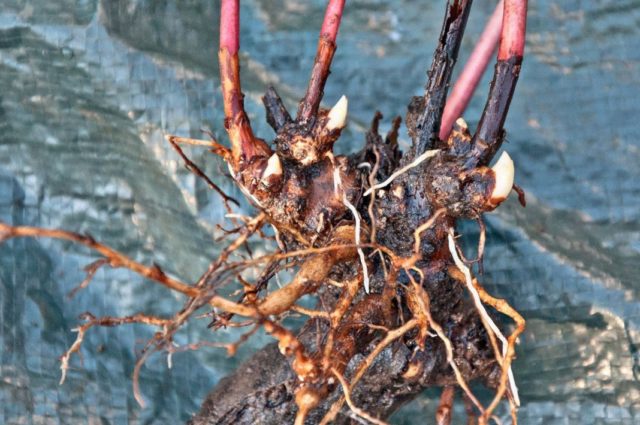
Peony rhizome with adventitious shoots
Planting stages:
- Dig a hole measuring 60x60 cm, cover the bottom with a 10 cm drainage layer (small pebbles, crushed brick, crushed stone, gravel).
- Wood ash, compost, peat, sand are mixed and sprinkled with soil, leaving 12 cm to the soil surface.
- The seedling is deepened by 7 cm.
- The soil is carefully compacted.
- Water and add soil when subsidence occurs.
- Mulch with a thin layer of rotted manure.
When planting in groups, the distance between the Marie Lemoine peony bushes is left at 1-1.5 m, since the plant is actively growing.
Aftercare
The Marie Lemoine variety begins to bloom at 2-3 years. Peony care consists of regular watering, fertilizing, loosening the soil and mulching.
Marie Lemoine needs moderate watering. Over-wetting the soil can lead to root rot. In summer, irrigate in the evening once every 10 days. The water requirement is 20 liters per adult bush. After watering, the soil is loosened to a width of up to 50 cm and a depth of up to 5 cm, making sure that the water does not linger around the peony for a long time. It is important to remove weeds in a timely manner.
For lush flowering of the Marie Lemoine variety, complex fertilizers are used. Feeding is carried out 3 times per season:
- After the snow melts, fertilize with nitrogen-potassium additives. A peony bush requires about 15 g of nitrogen and 20 g of potassium.
- During the formation of buds, they are fed with nitrogen, potassium, phosphorus: 15 g of the substance per bush.
- 2 weeks after flowering, fertilize with phosphorus-potassium fertilizers (30 g per bush)
In dry weather, fertilizers are diluted in water; in rainy weather, granular additives can be used, scattering them in a trench next to the tree trunk.
In addition, Marie Lemoine is treated with foliar mineral fertilizers sprayed with a spray bottle.
Natural organic fertilizers: compost or manure saturate the soil well and nourish the plant, mulching the soil with them before frost. The procedure protects the rhizome from hypothermia, loss of moisture and does not allow the soil to become too compact. Before mulching, it is advisable to sprinkle the ground with wood ash.
Preparing for winter
In the fall, peonies are prepared for the ground: they are cut and covered. Pruning is carried out with pruning shears, having previously disinfected it with alcohol. They leave small shoots. Then add a complex fertilizer based on potassium and phosphorus, or bone meal along with ash, loosen and lightly dig in.
To protect against sub-zero temperatures after the first frost, Marie Lemoine peonies are covered with peat, manure, humus or spruce branches. You can use special non-woven materials. Do not cover with cut tops.
Pests and diseases
Peonies are often infected by the mold Botrytis paeonia or gray mold. Symptoms of the disease: rotting of buds and petals, darkening of stems and leaves with the appearance of brown spots. The fungus develops very quickly and leads to withering and falling of the stems.The propagation of the pathogen is facilitated by cold, rainy weather, waterlogging of the soil, lack of air circulation and sudden temperature changes in summer and spring.
Another fungus that affects Marie Lemoine peonies is Cronartium flaccidum or rust. Signs of the disease: the formation of small brown spots, curling and drying of leaves, weakening of the plant. The development of the parasite is favored by humidity and warm weather.
Powdery mildew, a fungal disease caused by microscopic pathogens, poses a danger to peony. When infected, a white coating develops on the leaves, and droplets of liquid appear as the spores mature. The development of the pathogen at the initial stage can be easily stopped by irrigating with copper sulfate diluted in water.
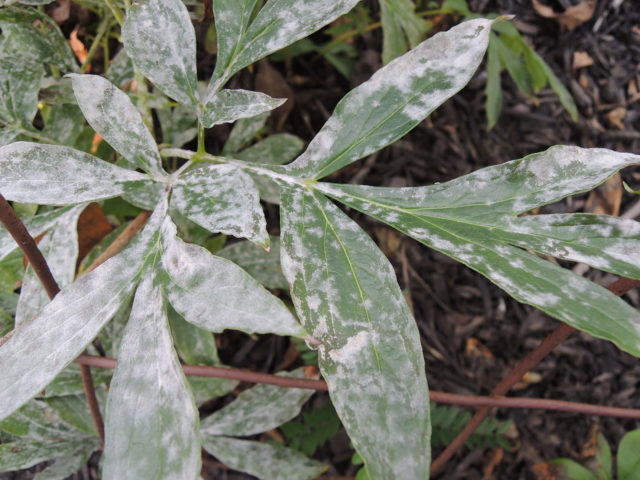
Powdery mildew affects peony leaves
Sometimes Marie Lemoine peonies are affected by root rot, caused by fungi Fusarium, Phytophthora, etc. The manifestation of the disease is darkening and wilting of the stems.
To prevent fungal diseases it is necessary:
- removal of damaged parts of the plant;
- limited use of fertilizers containing nitrogen;
- autumn pruning;
- moderate watering, avoid excessive soil moisture.
Fungicides are used for treatment, spraying in spring and summer. Infected leaves and stems are collected and burned.
Of the viruses for Marie Lemoine's peonies, the ring mosaic virus (Peony ringspot virus) is dangerous. The disease can be recognized by light spots on the leaves. If found, the damaged parts of the peony should be torn off and removed.
In addition to microorganisms, peonies can infect insects: ants, whiteflies, aphids. Insecticides are used for destruction. Aphicides help well against aphids.
Conclusion
Peony Marie Lemoine is an herbaceous light cream peony with large double flowers that resemble crowns. The variety is late, unpretentious and frost-resistant.With proper care, it blooms luxuriantly and is used in landscape design in both single and group plantings.



